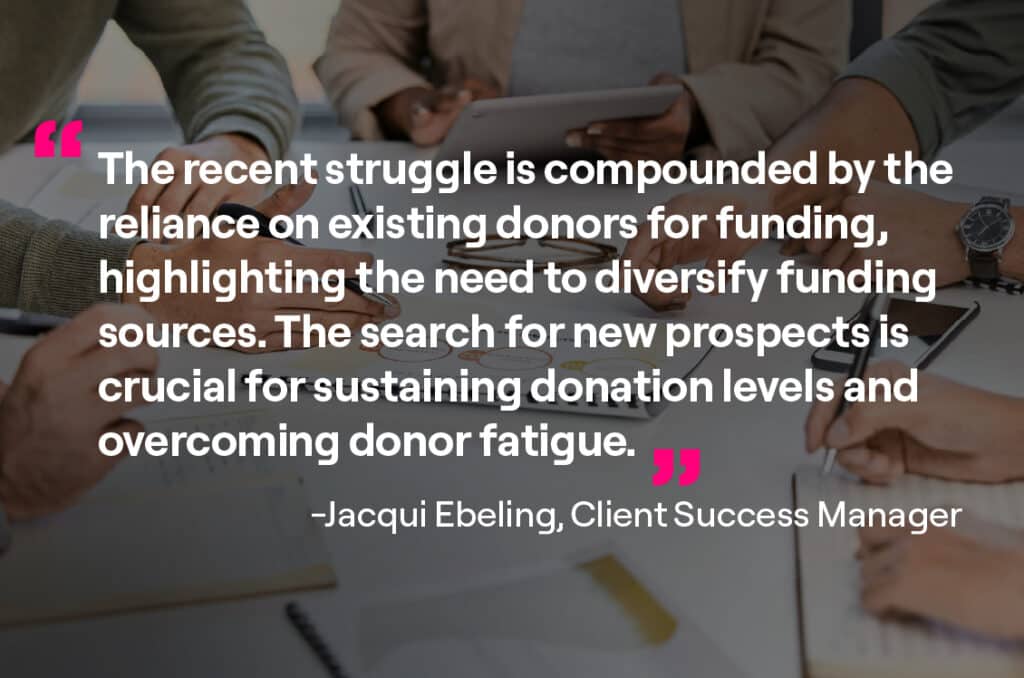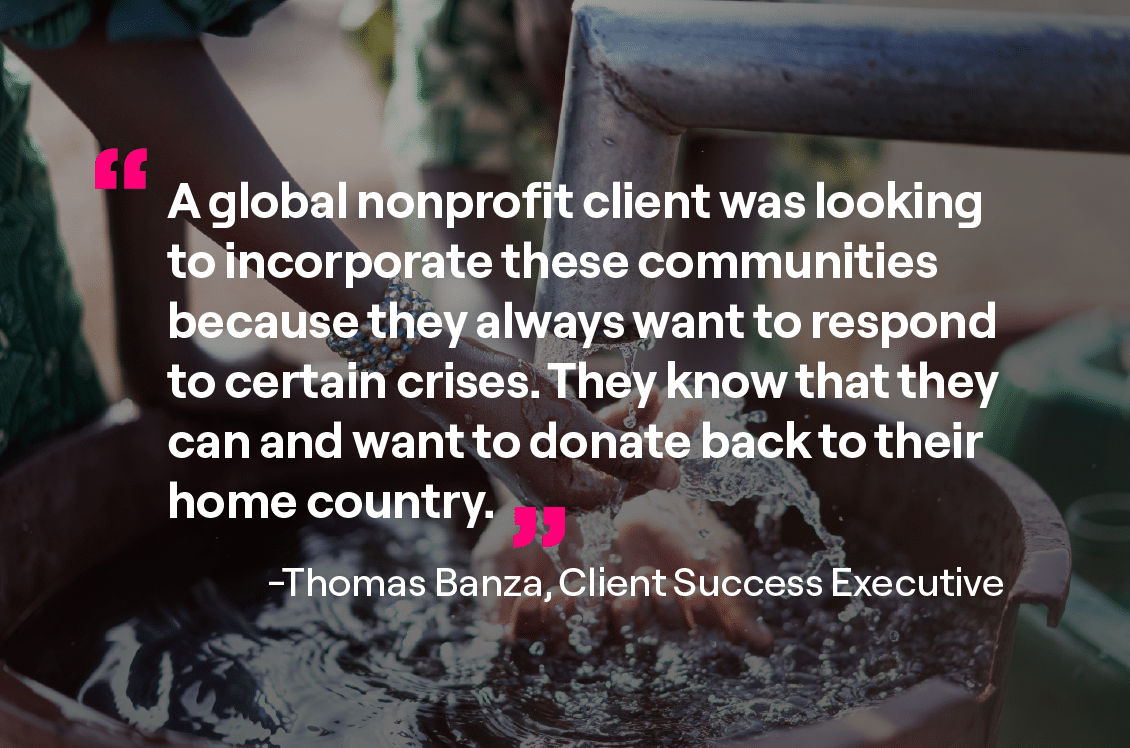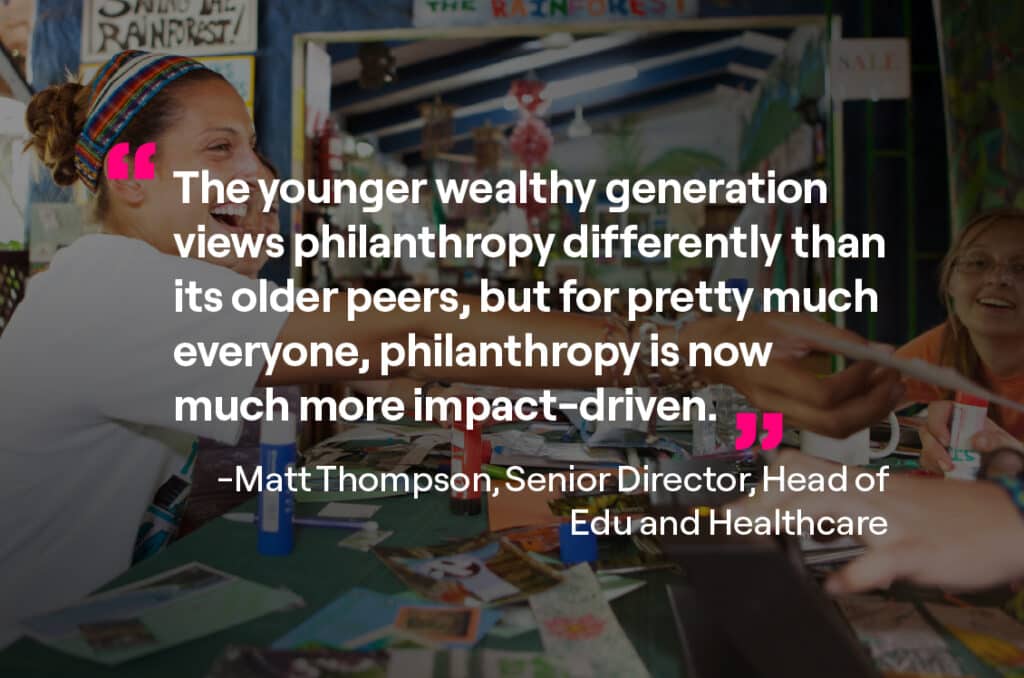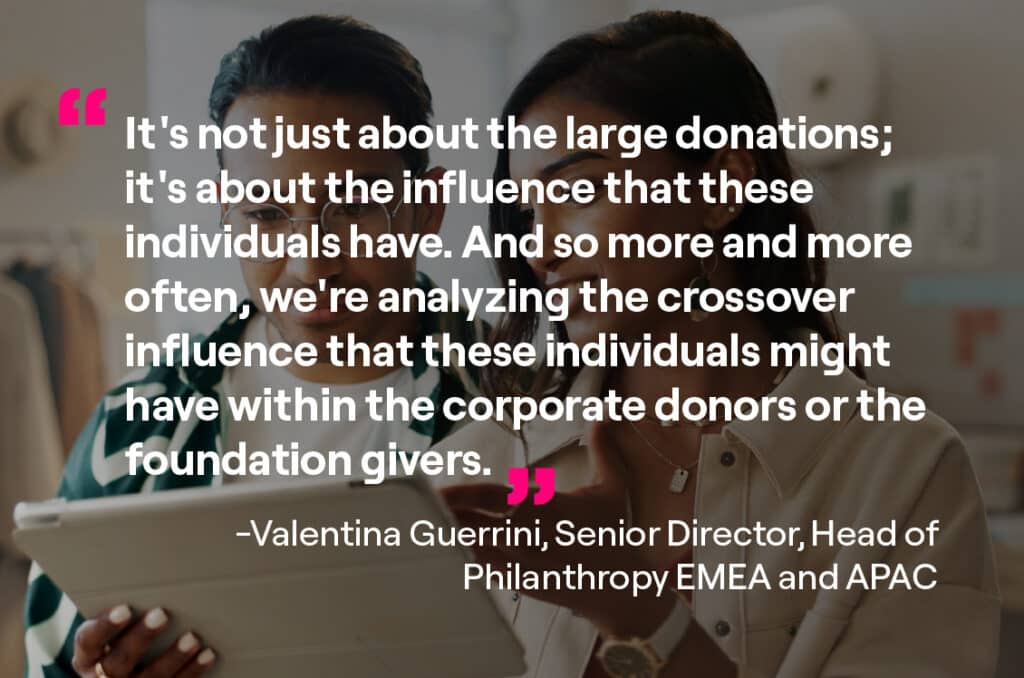Data-driven giving trends among the wealthy reveal important changes over time. Recent high-level findings from Altrata show that total giving by the ultra wealthy has increased by almost 25% since 2018, and that interests and affinities among the ultra wealthy have become more segmented.
These findings can help organizations evolve their strategy and make better decisions, ultimately bringing in more donations and advancing their mission. Additionally, by drawing on Altrata’s team of non-profit sector specialists and combining this with data from Altrata’s Wealth-X, they show some trends that every charitable organization should be tracking.
Let’s explore these insights to better understand how they can influence donor strategies and, ultimately, increase success during giving campaigns.
Globalized giving in a polarized world
While North America was home to nearly half of all global ultra high net worth (UHNW) donations in 2022, giving is steadily diversifying, and non-profit development is on the rise in many other regions. In Asia for example (the second-largest UHNW region globally), the modest 13% share of all giving is expected to increase substantially in the coming years.
A growing, globalized world impacts everything. Commerce, culture, and even philanthropy are all feeling the effects of a more connected world. For charitable organizations, this is actually a good thing, as we’ll see below.
Donor and institutional fatigue
Generally, most organizations find it difficult to find time to research and prospect. Their time is often spent managing their existing donors, thereby creating a reliance (and really, a dependence) on existing givers. Eventually, capacity problems arise, and organizations find themselves in a tough spot: with a fatigued donor and with little in the way of new leads.

Given the challenges of donor fatigue and institutional capacity, organizations must look to diversify their funding sources. This involves actively seeking new prospects to sustain donation levels and prevent an over-reliance on existing donors. As the trends suggest, for some, this comes in the form of developing an international donor portfolio.
Investing in prospect research and leveraging platforms (like Altrata’s wealth intelligence solutions) can help to identify new opportunities and alleviate these challenges, especially at an international level.
Prospecting: Interests vs. location
Having a tool is great, but knowing where to set your sights is altogether different.

When expanding your prospect pool, considering both the location and the interests of a potential donor is equally important. Besides tools like Wealth-X that help philanthropic organizations acquire more donors, many are finding success through volunteers or “ambassadors” who are aiding in the search.
Searching at the intersection
As an example, a large humanitarian nonprofit was using a strategy that involves both geography and interests to incorporate the international diaspora community. Using both geography and interest indicators, the organization was able to gather funding for certain crises and effectively target people likely to help, as they have done so in various countries across the world.

This diversity also points back to institutional goals. There is a large push towards the diversification of the donor base from a political perspective, but also from a practical one. Wealth is more diverse than ever, and garnering the influence of these individuals internationally is a strategy worth investing in. International donor portfolios are more valuable than ever before.

The landscape has been drastically changed by the availability of data. Using profiles from powerful platforms, philanthropic organizations are able to segment and connect with donors across borders and even through shared ideological, faith, and cultural beliefs. Thanks to the internet, globalized communities can be tapped into, provided you have the right tools. A tool like Wealth-X can help you identify which donors or organizations to tap into using exclusive data with deep, impactful insights.
Generational giving differences
Generational differences play a significant role in shaping philanthropic trends, particularly among current and soon-to-be wealthy individuals. Younger generations such as millennials and those of gen Z approach giving differently than their older counterparts. These differences should inform donor engagement and giving practices. These younger donors are more focused on impact, transparency, and innovation. They are also more likely to support causes aligned with their values and to engage with organizations in a more hands-on manner. This desire is known as “transformational impact,” and it’s one of the key differences between age segments.

Additionally, there is a growing trend among donors of all ages to seek deeper, more meaningful relationships with the nonprofits they support. They are no longer satisfied with just making donations; they want to feel a personal connection to the cause and the organization.
This shift has led to an increased emphasis on storytelling, transparency, and communication from nonprofits as they seek to build and maintain these relationships over time. Ultimately, these donors don’t just want to give money and walk away; they want to be involved in the process and have engagement with the work being done.
The motivations of the young and wealthy
Is there a viable reason to spend time targeting relationships with the upcoming generation? Currently, only 6% of UHNW individuals who have a high affinity for giving are under 50 years old (though this is also due to the fact that the average age of the ultra wealthy is 66). Is taking the time really worth it?
It is and it will be increasingly important to do so. Wealth-X found that younger people are significantly more philanthropically-oriented and geared towards direct engagement with nonprofits. Importantly, there is a huge wealth “handoff” coming (and already partly underway). As the wealth accumulated by older generations is handed down to family (in addition to organizations directly), this transfer means younger and more recently-made wealthy will have the means to make large and impactful gifts.
Using platforms like Wealth-X can help prospects leverage familial connections, especially in light of inheritance. This will likely be particularly effective when paired with strategies geared to engage young, wealthy (and soon-to-be) individuals as they prefer, mostly through a chance to be involved in the giving process more directly.
The value of personalized connections
Perhaps the most important trend established in a recent Altrata study on philanthropic trends finds that personalized connections are the most important factor for any type of charitable giving. Donors are seeking more than just a transactional relationship with nonprofits. They crave intentional connections and tangible impact from their giving.

It’s about more than just technology and data; it’s about reaching out personally, inviting donors to events, and showing them the real impact of their contributions. Even more, viewing the UHNW individual as just a number isn’t the future. The relational change and influence they have is far more valuable (although it often relates to higher giving, sure).
Technology has certainly made it easier to connect with donors globally, but building trust and loyalty requires a personal touch. This means understanding their values, interests, and goals, and aligning these with the nonprofit’s mission and impact. Then, with that understanding, organizations can be creative with how they approach connecting with donors.
In this context, Wealth-X’s donor profiles play a pivotal role. These profiles provide invaluable insights into potential donors’ interests, allowing nonprofits to tailor their approach and create a more personalized connection. By leveraging Wealth-X’s data, nonprofits can gain a deeper understanding of donors’ motivations and values, enabling them to forge stronger, more meaningful relationships.
The key to giving success
Recent giving trends in a globalized world, amid changing generational preferences and a need for personalized approaches are an opportunity for charitable organizations to capitalize on fresh ground.
Using the right tools can help connect you with potential donors and giving funds around the world, then connect and close deals that can help further your mission. When you have great data on donors, you can ask meaningful questions and establish long-term personal philanthropic relationships.
Wealth-X can help organizations understand and adapt to these trends and increase incoming funds. Get a free demo and see how it can supercharge your fundraising efforts.
Maya Imberg is the Head of Thought Leadership and Analytics at Altrata. She is responsible for spearheading the company’s thought leadership efforts and overseeing its analytics and predictive modeling services commissioned by clients. She joined Wealth-X in 2016 as Director of Custom Research responsible for secondary research, data analytics and branded content. Maya has over fifteen years of experience in research, spanning market research, macroeconomics and financial services. Prior to joining Wealth-X, Maya held a variety of consultant and economist roles at the Economist Intelligence Unit and spent a number of years working for Datamonitor’s Financial Services practice. Maya holds an undergraduate and MSc degree in economics and comparative politics from the University of Pennsylvania and London School of Economics respectively.